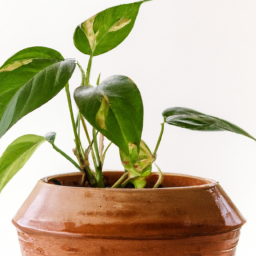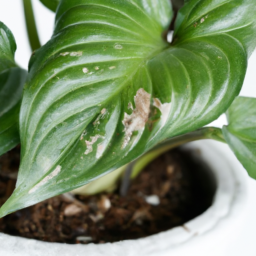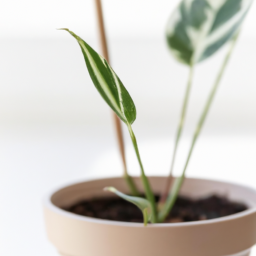
Are you looking to add some greenery to your home but don’t have a green thumb? Look no further! In this blog post, we will discuss the easiest plant to grow at home. Whether you’re a seasoned gardener or a complete beginner, this plant is perfect for anyone looking to add some life to their living space without all the hassle. So sit back, relax, and let’s dive into the world of easy indoor gardening.
The Benefits of Growing Succulents Indoors
Succulents are a popular choice for indoor plants due to their low maintenance requirements and unique appearance. These plants are known for their ability to store water in their leaves, making them perfect for busy individuals or those with a black thumb. In addition to their easy care, succulents offer a variety of benefits when grown indoors.
Improves Indoor Air Quality
One of the major benefits of growing succulents indoors is their ability to improve indoor air quality. Like other plants, succulents absorb carbon dioxide and release oxygen through the process of photosynthesis. This can help to purify the air in your home, making it healthier for you and your family to breathe. In addition, succulents have been shown to remove toxins such as formaldehyde and benzene from the air, further improving indoor air quality.
Succulents are also known for their ability to increase humidity levels in the air. This can be especially beneficial during the dry winter months when indoor air tends to be drier. By releasing moisture through their leaves, succulents can help to create a more comfortable indoor environment and reduce the risk of respiratory issues caused by dry air.
In addition to improving air quality, succulents can also help to reduce noise levels in your home. The leaves of succulents can absorb and diffract sound waves, helping to create a quieter indoor environment. This can be especially beneficial for those who live in noisy urban areas or have loud neighbors.
Enhances Mental Well-being
In addition to their physical benefits, growing succulents indoors can also have a positive impact on your mental well-being. Studies have shown that interacting with plants, such as watering and caring for succulents, can help to reduce stress and anxiety levels. The act of nurturing a living thing can be therapeutic and provide a sense of purpose and accomplishment.
Succulents can also help to improve mood and increase feelings of happiness and well-being. Their unique shapes, colors, and textures can provide visual interest and create a calming and relaxing atmosphere in your home. Simply having succulents around you can help to lift your spirits and create a sense of tranquility.
In addition, caring for succulents can help to improve focus and concentration. The act of tending to plants requires mindfulness and attention to detail, which can help to improve cognitive function and mental clarity. Having succulents in your home can create a sense of mindfulness and presence, helping you to stay grounded and focused on the present moment.
Easy to Care For
One of the biggest benefits of growing succulents indoors is their low maintenance requirements. Succulents are extremely hardy plants that can thrive in a variety of indoor conditions. They require minimal watering and can tolerate periods of neglect, making them perfect for busy individuals or those with a hectic schedule.
To care for succulents indoors, simply place them in a sunny window where they can receive bright, indirect light. Water sparingly, allowing the soil to dry out completely between waterings. Avoid overwatering, as this can lead to root rot and other issues. In addition, make sure to provide good drainage for your succulents by planting them in a well-draining soil mix and using pots with drainage holes.
With their unique appearance, air-purifying qualities, and mental health benefits, succulents are a wonderful choice for indoor plants. Whether you are a seasoned plant parent or a beginner looking to add some greenery to your home, succulents are a great option that is sure to bring joy and beauty to your space.

Tips for Growing Herbs in Your Kitchen
Choosing the Right Herbs
Growing herbs in your kitchen can be a rewarding experience, both in terms of the convenience of having fresh herbs at your fingertips and the satisfaction of watching your plants thrive. When choosing which herbs to grow, consider your cooking preferences and the amount of natural light your kitchen receives. Some popular herbs that are relatively easy to grow indoors include basil, mint, parsley, chives, and thyme.
It’s important to select herbs that will thrive in the conditions of your kitchen. For example, if your kitchen receives a lot of natural light, you may want to choose herbs that require full sun, such as basil and thyme. On the other hand, if your kitchen is on the darker side, consider herbs that can tolerate lower light levels, like mint and parsley. Additionally, think about the flavors and scents you enjoy most in your cooking, as this will help you narrow down your herb choices.
Once you’ve selected your herbs, it’s time to choose the right containers for planting. Herbs can be grown in a variety of containers, including pots, planters, and even mason jars. Make sure your containers have drainage holes to prevent water from pooling at the bottom, which can lead to root rot. You can also add a layer of gravel or small rocks at the bottom of your containers to improve drainage.
Providing the Right Growing Conditions
In order for your herbs to thrive, it’s important to provide them with the right growing conditions. Most herbs prefer well-draining soil that is rich in organic matter. You can use a pre-packaged potting mix designed for herbs or create your own by mixing equal parts of potting soil, perlite, and compost. Make sure to water your herbs regularly, but be careful not to overwater, as this can lead to root rot.
Herbs also require adequate sunlight to grow and thrive. Most herbs prefer at least 6-8 hours of sunlight per day, so be sure to place your herb containers in a sunny spot in your kitchen. If natural light is limited, you can supplement with a grow light to ensure your herbs receive enough light to grow. Rotate your herb containers regularly to promote even growth and prevent your plants from leaning towards the light source.
In addition to sunlight, herbs also benefit from good air circulation. To promote air circulation around your plants, avoid overcrowding your containers and make sure to space your herbs out evenly. If you notice any signs of mold or mildew on your herbs, increase air circulation by placing a small fan near your plants or opening a window in your kitchen.
Caring for Your Herbs
Caring for your herbs is relatively simple, but it does require some attention to detail. Regularly check the soil moisture of your herb containers by sticking your finger into the soil up to the first knuckle. If the soil feels dry, it’s time to water your herbs. Water your herbs at the base of the plant until water starts to drain out of the bottom of the container, then allow the soil to dry out slightly before watering again.
To promote healthy growth, you can also fertilize your herbs every 4-6 weeks with a balanced liquid fertilizer. Be sure to follow the instructions on the fertilizer label and avoid over-fertilizing, as this can lead to nutrient imbalances in your plants. Prune your herbs regularly to encourage bushy growth and prevent them from becoming leggy. You can use the trimmings in your cooking or dry them for later use.
By following these tips for growing herbs in your kitchen, you can enjoy a bountiful harvest of fresh, flavorful herbs year-round. With a little care and attention, you’ll soon be reaping the rewards of your indoor herb garden.

Low-Maintenance Houseplants for Beginners
Choosing the Right Plant
When it comes to choosing the easiest plant to grow at home, there are a few key factors to consider. First and foremost, you’ll want to pick a plant that thrives in low light conditions, as this will make it much easier to care for. Some great options for low-light plants include pothos, snake plants, and peace lilies.
Another important factor to consider is the plant’s water requirements. If you tend to forget to water your plants regularly, you’ll want to choose a plant that is more forgiving when it comes to watering. Succulents, for example, are a great choice for forgetful gardeners, as they store water in their leaves and can go longer periods between waterings.
Lastly, consider the size of the plant and how much space you have available in your home. If you’re limited on space, opt for a smaller plant like a spider plant or aloe vera. These plants are not only easy to care for but also make great additions to any room.
Caring for Your Plant
Once you’ve chosen the perfect low-maintenance houseplant for your home, it’s important to know how to care for it properly. One of the most important things to remember is to not overwater your plant. Most houseplants prefer to dry out between waterings, so be sure to check the soil before reaching for your watering can.
In addition to proper watering, it’s also important to provide your plant with the right amount of light. While low-light plants can thrive in indirect sunlight, it’s important to avoid placing them in direct sunlight, as this can cause their leaves to burn. If you’re unsure about how much light your plant needs, do some research or ask a local nursery for guidance.
Lastly, be sure to regularly dust off your plant’s leaves and check for any pests. Dust can accumulate on the leaves of your plant, which can block sunlight and hinder its growth. If you notice any pests, such as spider mites or aphids, treat them promptly with an insecticidal soap or neem oil spray.
Troubleshooting Common Issues
Even the easiest plants to grow at home can run into issues from time to time. If you notice your plant’s leaves turning yellow or brown, it could be a sign of overwatering. In this case, allow the soil to dry out before watering again and adjust your watering schedule accordingly.
If your plant’s leaves are drooping, it could be a sign of underwatering. Give your plant a thorough watering and adjust your watering schedule to ensure it’s getting enough moisture. If the problem persists, consider repotting your plant into a larger container with fresh soil.
By following these tips and choosing the right low-maintenance houseplant for your home, you can enjoy the beauty of indoor gardening without the stress of high-maintenance plants. Remember to have fun and enjoy the process of caring for your new leafy friend!
In a Nutshell
Looking to add some greenery to your home but don’t have the greenest of thumbs? Look no further than the spider plant! This easy-to-grow plant is perfect for beginners and seasoned gardeners alike. Spider plants are known for their long, thin leaves that cascade elegantly from the center of the plant. They require minimal care and can thrive in a variety of lighting conditions, making them a versatile option for any home.
Spider plants are also great for purifying the air in your home, making them a functional and aesthetically pleasing addition to any room. To care for your spider plant, simply water it when the soil feels dry to the touch and place it in indirect sunlight. With a little love and attention, your spider plant will flourish and bring a touch of nature into your living space. So why wait? Pick up a spider plant today and enjoy the beauty and benefits of this easy-to-grow plant in your home.
Let me leave you with some FAQs:
Q1: What is the easiest plant to grow at home?
A1: The easiest plant to grow at home is usually a succulent, such as aloe vera or a snake plant. These plants require minimal care and can thrive in various conditions.
Q2: Do I need a green thumb to grow plants at home?
A2: No, you don’t need a green thumb to grow plants at home. Many plants, like spider plants or pothos, are low-maintenance and perfect for beginners.
Q3: How much sunlight do plants need to grow indoors?
A3: Most indoor plants need at least a few hours of indirect sunlight each day. However, there are also low-light plants that can thrive in shady areas.
Q4: What are some easy-to-care-for herbs I can grow at home?
A4: Some easy-to-care-for herbs you can grow at home include basil, mint, and parsley. These herbs are relatively low-maintenance and can be grown indoors or outdoors.
Q5: How often should I water my indoor plants?
A5: The frequency of watering indoor plants depends on the type of plant and the environment it’s in. As a general rule, it’s best to let the soil dry out slightly between waterings to prevent overwatering.
Dr. Olivia Green is a botanist with over two decades of experience in indoor plant cultivation. She holds a Ph.D. in Plant Biology and has dedicated her career to researching plant behavior in controlled environments. Dr. Green is passionate about helping plant enthusiasts master the art of indoor gardening through her extensive knowledge and practical insights.


